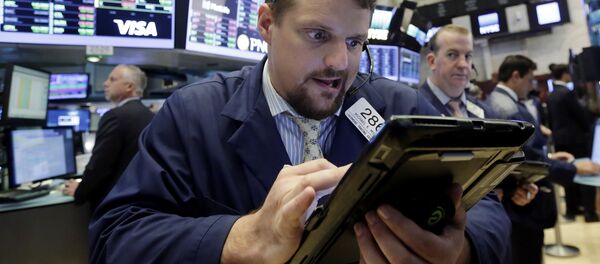Kristian Rouz — The underperforming growth of US prices stands in the way of further Federal Reserve policy tightening, thus putting into question the feasibility of the White House's promised fiscal reform. Inflation remained unchanged in July and below the Fed target, meaning the next Fed interest rate hike is a more distant perspective than anticipated earlier.
Annualized US inflation remained steady at 1.7 percent in July, same as the previous month and in May on a core basis. Low gains in disposable incomes have impaired US consumers' purchasing power, who responded with weaker spending on major purchases. Even a weaker dollar failed to provide momentum for the growth of US prices, despite dearer imports.
Subsequently, Fed policymakers will most likely to abstain from hiking interest rates in the coming months, especially because the central bank is planning to start balance sheet reductions in September — another necessary, but inflation-unfriendly move.
Moreover, as the Fed policies still remain fairly loose, with base borrowing costs at 1-1.25 percent, the Trump administration has to be very cautious in their estimates of the effects of the looming fiscal stimulus in the form of tax cuts and greater infrastructure investment. Excessive fiscal stimulus in the low interest rate environment would push the US economy closer to overheating, with asset bubbles likely in the overvalued stock market, for example.
"The CPI [Core Prices Index, base inflation] data was very muted and not something which the Fed is going to be happy to look it," Naeem Aslam of Think Markets UK Ltd. said.
Furthermore, the Labor Department said, monthly inflation gains were just 0.1 percent in July, as food prices rose 0.2 percent, but energy, including petrol, dropped 0.1 percent.
The US labor market is at "full employment," however, with the jobless rate at 4.3 percent and economic growth in Q2 picking up to 2.6 percent. Paradoxically, these strong fundamentals are failing to translate into higher wages and living standards. Plus, US households are heavily indebted, which, in the Fed policy tightening cycle, renders the consumer even more vulnerable and reluctant to spend.
"We believe the Fed will focus on the balance sheet in September, foregoing another rate hike until December," said James Bohnaker of IHS Markit in Lexington, MA. "The inflation outlook will not change drastically anytime soon."
Indeed, the US economy is facing structural challenges that hinder the normal mechanisms of policy and financial market dynamics transmission to the real economy. US growth is driven by the expansion in the financial, health care and IT sectors, whilst the low unemployment stems from the abundance of low-paying jobs. The robust health care sector, on its part, capitalizes on mandatory health insurance plans and high medication prices in a monopolized market.
Although President Trump has repeatedly blasted Big Pharma and the immoral hiring practices of many US employers, his administration has thus far done little to address the stunningly high living costs in the US and low wages across most sectors of the economy.
Previous forecasts projected US inflation on course to the Fed's 2 percent target at 1.8 percent in July. These expectations failed to materialize, and now that the summer vacation season is nearly over, prices are lacking the driving force behind them.
Federal Reserve Chair Janet Yellen said the declining prices on mobile phone plans have hampered inflation. While such plans have indeed dropped 0.3 percent, an average $50 monthly cell phone plan is hardly affordable, with family lines taking $100 or more from their household budget on a monthly basis, not to mention the prevalent credit costs of owning a smartphone.
Not all current estimates are gloomy, however, as inflation is still expected to pick up, as it has been for the past 12 months.
"One-time factors that have slowed inflation will gradually dissipate," Gus Faucher of PNC Financial Services in Pittsburgh, PA said. "Stronger wage growth as businesses compete for scarce workers will also contribute to higher inflation in the second half of this year and in 2018."
Whilst workforces are scarce, low labor productivity adds to the employer drive to automate their operations. Wage growth is nowhere to be seen in the coming months unless US manufacturing posts more solid gains, whilst a tax reform could help higher-paid positions.
The still-alive Obamacare also keeps hampering living standards, as many employers have to contribute to their workers' mandatory plans, up to 15 percent of their monthly paycheck. A repeal of Obamacare could drive the disposable incomes of US consumers; however, amidst the congressional conundrum on this and other matters, this is not happening anytime soon.
Therefore, the US economy is likely to keep posting upbeat macro data in at least the coming two quarters, whilst inflation and all major consumer-related indicators will keep underperforming. A decisive action on the economy and health care from the White House is expected, but positive expectations gradually dissipate as businesses are losing their enthusiasm over Donald Trump: only 44 S&P 500-listed companies mentioned Trump when reporting their earnings for 2Q17, whilst in February, 181 companies mentioned the president in their profits reports.




